| Strain Name |
|
Common Name |
B-NDG hTHPO mice |
| Background | B-NDG | Catalog number | 110590 |
|
Related Genes |
THPO (thrombopoietin) |
||
|
NCBI Gene ID |
21832 | ||
Description
The use of severely immunodeficient mice engrafted with human hematopoietic stem cells (HSCs) to recontitute immune system humanized mice has provided researchers with powerful tools for virus research and cellular immunotherapy preclinical evaluation of the human immune system and related primates. However, the maintenance, differentiation, and function of human hematopoietic cells are not ideal in these hosts. Human thrombopoietin (THPO) promotes functional human hematopoietic stem cells to maintain their multilineage differentiation potential and promote their long-term engraftment in mouse bone marrow.
Biocytogen developed B-NDG hTHPO mice in which the full-length THPO gene sequence of mice was replaced with the full-length coding sequence of the human THPO gene to obtain severely immunodeficient mice expressing human THPO. Humanization of THPO can promote the long-term maintenance and self-renewal of human HSCs in mice. So mice without irradiation pretreatment can also well reconstitute the human immune system, and can promote the multi-lineage differentiation of hematopoietic cells.
General information
Genomic organization and expression of the Thpo gene
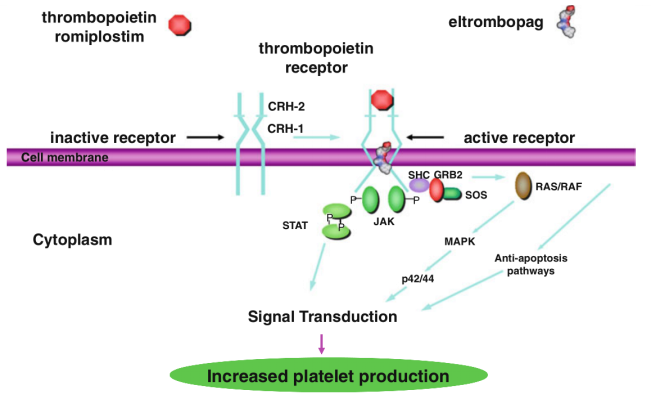
Fig. 2 Activation of the TPO receptor by TPO or TPO receptor agonists. TPO and romiplostim bind to the distal cytokine receptor homology domain (CRH-2) of the preformed, inactive TPO receptor dimer. Eltrombopag binds to the transmembrane region of the TPO receptor. Multiple signal transduction pathways are thereby activated.
mRNA expression analysis
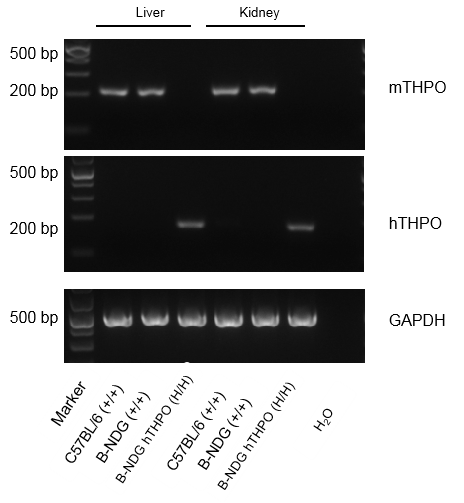
B-NDG hTHPO mice are well suited for human immune system engraftment
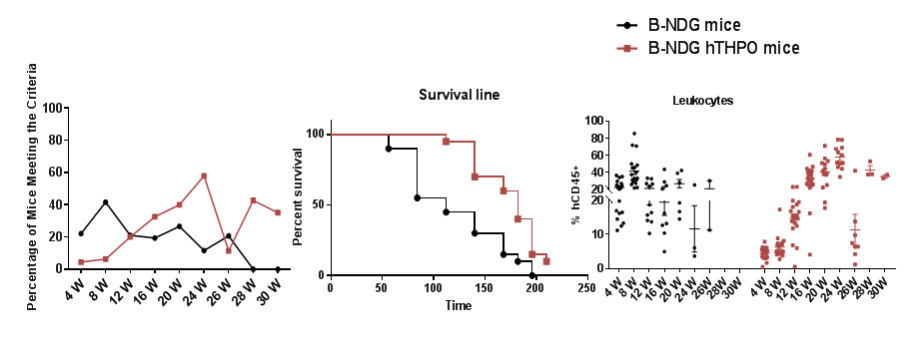
Human CD34+ cells(5E5) were intravenous implanted into homozygote B-NDG hTHPO and B-NDG mice (female, 6 week-old, n=20). B-NDG mice were treated with 2Gy-irradiation, B-NDG hTHPO mice were not irradiated. Representative flow cytometric analysis of peripheral blood lymphocyte from mice after engraftment with human CD34+ cells. B-NDG hTHPO mice show a higher percentage of survival rate compared with B-NDG.Non-irradiated B-NDG hTHPO mice showed no difference in the percentage of human CD45+ cells compared to B-NDG mice. The results showed that the human HSC (hematopoietic stem cells) engrafted humanized mice model was successfully constructed.
B-NDG hTHPO mice can successfully reconstitute the human immune system without irradiation
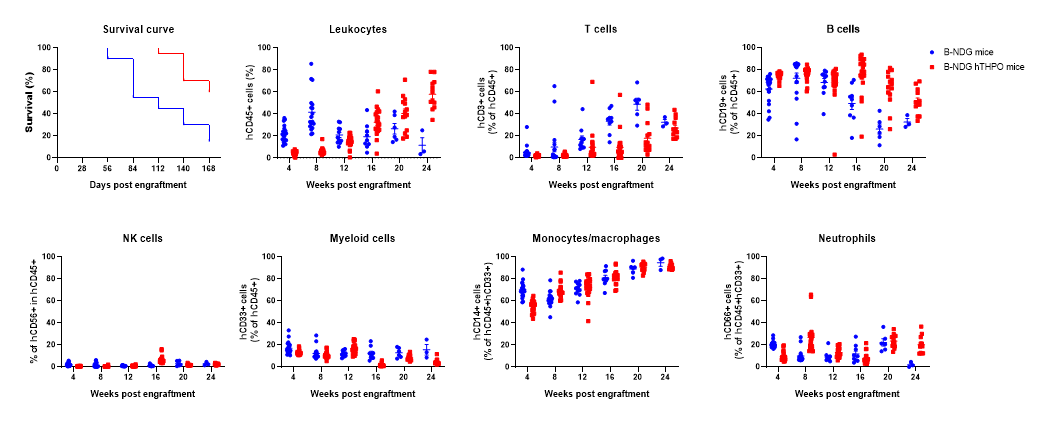 Human immune system was successfully reconstituted by engraftment of human CD34+ HSCs to B-NDG hTHPO mice without irradiation.
Human immune system was successfully reconstituted by engraftment of human CD34+ HSCs to B-NDG hTHPO mice without irradiation.
Human CD34+ HSCs (5E5) were intravenously injected into non-irradiated B-NDG hTHPO mice and 2.0 Gy irradiated B-NDG mice (female, n = 15). The peripheral blood was taken every 2 weeks to analyze the proportion of reconstituted human immune cells. The results showed that the survival rate of non-irradiated B-NDG hTHPO mice was significantly higher than that of irradiated B-NDG mice. But there was no significant difference in the percentage of human multilineage cells, including T, B, NK, myeloid cells, monocytes and neutrophils. The results indicated that B-NDG hTHPO mice were able to successfully recontitute the human immune system without irradiation.

Human CD34+ cells(5E5) were intravenous implanted into homozygote B-NDG hTHPO (female, 6 week-old, n=20). and B-NDG mice (female, 6 week-old, n=17). B-NDG mice were treated with 1.6Gy-irradiation, B-NDG hTHPO mice were not irradiated. Representative flow cytometric analysis of peripheral blood lymphocyte from mice after engraftment with human CD34+ cells. B-NDG hTHPO mice show a higher percentage of survival rate compared with B-NDG. Non-irradiated B-NDG hTHPO mice showed no difference in the percentage of human CD45+ cells compared to B-NDG mice. The results showed that the human HSC (hematopoietic stem cells) engrafted humanized mice model was successfully constructed.
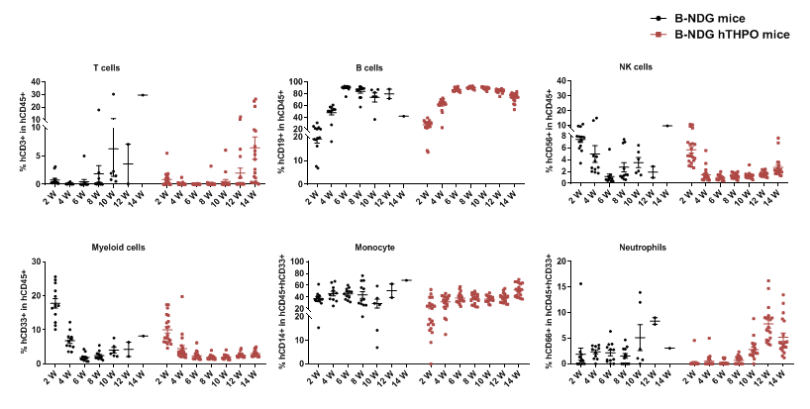
Human CD34+ cells(5E5) were intravenous implanted into homozygote B-NDG hTHPO (female, 6 week-old, n=20). and B-NDG mice (female, 6 week-old, n=17). B-NDG mice were treated with 1.6Gy-irradiation, B-NDG hTHPO mice were not irradiated. Representative flow cytometric analysis of peripheral blood lymphocyte from mice after engraftment with human CD34+ cells. Non-irradiated B-NDG hTHPO mice showed no difference in the percentage of human multi-lineage cells compared to B-NDG mice, including T ,B, NK, myeloid cells,monocyte and neutrophils. The results showed that the human HSC (hematopoietic stem cells) engrafted humanized mice model was successfully constructed.
- Kuter, D. J. The biology of thrombopoietin and thrombopoietin receptor agonists. International journal of hematology 98, 10-23, doi:10.1007/s12185-013-1382-0 (2013).
- Rongvaux A, et al., Human thrombopoietin knockin mice efficiently support human hematopoiesis in vivo. Proc Natl Acad Sci U S A. 2011 Feb 8;108(6):2378-83









